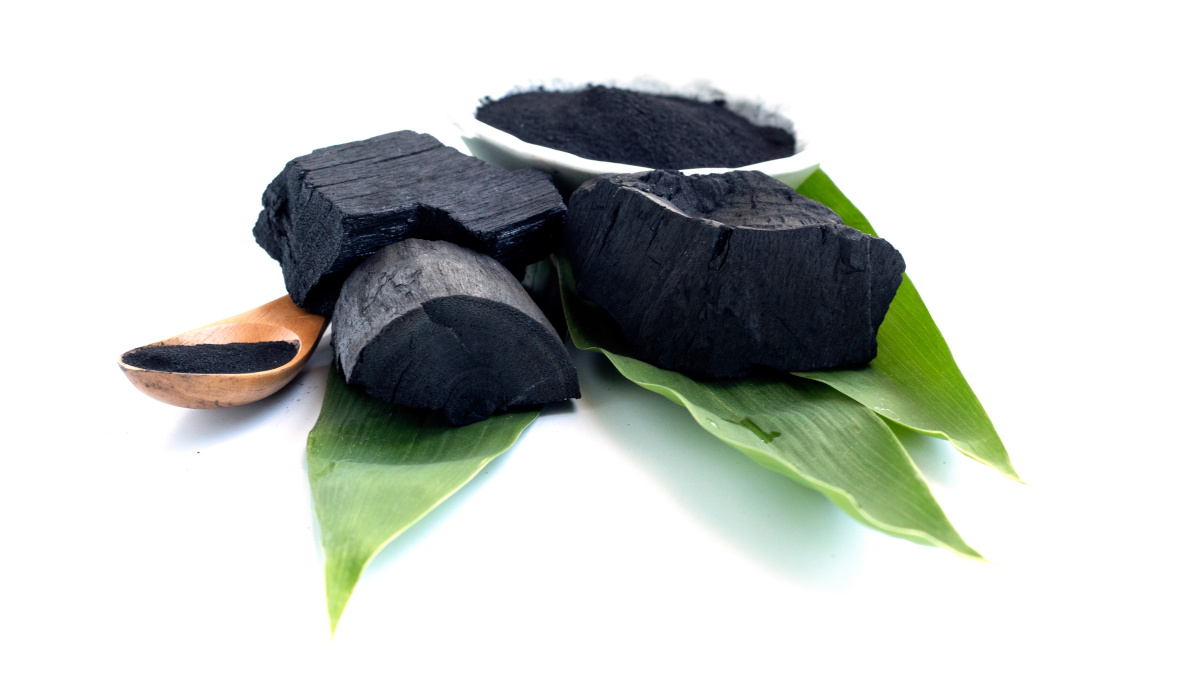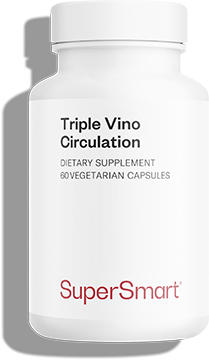Activated charcoal: how does it relieve intestinal gas?
Used for thousands of years, activated charcoal is reputed to be the most effective natural remedy for reducing gas. Discover precisely how this substance works to combat bloating and flatulence.

Recap: what causes intestinal gas?
Production of intestinal gas is a normal process that affects everyone. It is primarily caused by the accumulation of ingested air in the gut (mostly taken in when we eat), as well as by the fermentation by gut bacteria of certain non- or low-digestible carbohydrates (such as FODMAPs) (1-2). The resulting gas is then released in the form of flatulence: healthy males, for example, pass wind around 14 times a day on average, mainly after meals (3).
Some people, however, suffer from excessive flatulence. This is normally the result of over-fermentation, abnormally long retention of air in the intestinal tract, or the presence of certain bacteria in the gut flora. Occasionally, it can be caused by malabsorption or a food intolerance.
Though harmless in itself, flatulence is often synonymous with social embarrassment and digestive discomfort. It is sometimes accompanied by bloating, abdominal distension or pressure, loud gurgling (or borborygmi to use the medical term), and even pain in the navel and lower abdomen areas (5).
What exactly is activated charcoal?
Also known as activated carbon, activated charcoal is made from a carbon-rich raw material. This can be either animal-source (bone) or plant-source (wood, coconut shells …)
Unlike the charcoal we use for barbecues, activated charcoal undergoes various treatments which profoundly change its structure. The aim is to increase its surface area and make it more porous.
With lots of small holes in its sponge-like surface, activated charcoal easily captures and retains a whole host of undesirable compounds: this is known as adsorption. As our ancient forebears guessed, it is this property – exploited by Hippocrates himself – which is responsible for its many therapeutic applications, particularly in the areas of decontamination and detoxification (6-7).
This structural transformation takes place in two stages:
- carbonization: here, the carbon is charred at very high temperatures (600°C-900°C) to eliminate impurities and ensure only the charcoaled matrix remains. The initial ‘dimples’, the pores, become wider;
- activation: whether physical (thermal shock) or chemical (use of acids), activation unblocks the pores by removing tar to further increase its adsorbent capacity.
Activated charcoal and flatulence: how does it work?
It’s now recognised that activated charcoal helps to reduce excessive post-prandial flatulence (8). So by extension, it also has a beneficial effect on associated bloating, by relieving the abdominal area of this ‘weight of air’. But how does it actually do this?
Once ingested, activated charcoal reaches the gut intact: it is neither denatured nor altered by digestion (9).
It’s at this point that its adsorption properties come into play. With a negative electrical charge, its outer surface attracts positively-charged particles – including gases and certain toxins – trapping them in its pores. Like a magnet, but on a microscopic scale!
Though it’s tempting to use the sponge metaphor, it’s not strictly accurate. The substances captured do not get through to the heart of the charcoaled structure (unlike water which seeps into the foam of a sponge). They remain on the surface, settling in the cavities created by the activation – like a key entering a lock.
Though neutralised, the adsorbed compounds are not physically destroyed: they complete their journey anchored to the charcoal, right up to the end of the digestive tract, where they are then excreted via stools.
What is the link between activated charcoal and gut flora?
Although the mechanisms responsible require further clarification, activated charcoal may, by trapping certain waste-products in its net, have a direct effect on gut microbiota composition. Scientists are currently investigating its use as an adjuvant to those antibiotics likely to disrupt the balance of bacterial flora (10).
And it seems that an unstable flora with little diversity may be associated with lower tolerance to intestinal gases (11).
Which activated charcoal supplement should you choose?
Depending on the activation process used, activated charcoal has varying degrees of porosity which determines the type of molecule adsorbed. Trapping gases requires very narrow pores (sometimes less than a nanometre) (12).
And the quality of the raw material used influences the number and size of pores obtained (13).
It’s best, then, to opt for a plant-source activated charcoal with a sufficiently granular micropore network, which will ensure more effective adsorption of intestinal gases (the supplement Charcoal, obtained from a resinous wood, is activated to produce ultra-fine porosity).
References
- Magge S, Lembo A. Low-FODMAP Diet for Treatment of Irritable Bowel Syndrome. Gastroenterol Hepatol (N Y). 2012 Nov;8(11):739-45. PMID: 24672410; PMCID: PMC3966170.
- Cormier RE. Gaz abdominal. Dans : Walker HK, Hall WD, Hurst JW, éditeurs. Méthodes cliniques : l'histoire, les examens physiques et de laboratoire. 3ème édition. Boston : Butterworths ; 1990. Chapitre 90. Disponible sur : https://www.ncbi.nlm.nih.gov/books/NBK417/
- Hasler WL. Gas and Bloating. Gastroenterol Hepatol (N Y). 2006 Sep;2(9):654-662. PMID: 28316536; PMCID: PMC5350578.
- Deng Y, Misselwitz B, Dai N, Fox M. Lactose Intolerance in Adults: Biological Mechanism and Dietary Management. 2015 Sep 18;7(9):8020-35. doi: 10.3390/nu7095380. PMID: 26393648; PMCID: PMC4586575.
- Zhang L, Sizar O, Higginbotham K. Meteorism. [Updated 2021 Oct 21]. In: StatPearls [Internet]. Treasure Island (FL): StatPearls Publishing; 2022 Jan-. Available from: https://www.ncbi.nlm.nih.gov/books/NBK430851/
- Zellner T, Prasa D, Färber E, Hoffmann-Walbeck P, Genser D, Eyer F. The Use of Activated Charcoal to Treat Intoxications. Dtsch Arztebl Int. 2019 May 3;116(18):311-317. doi: 10.3238/arztebl.2019.0311. PMID: 31219028; PMCID: PMC6620762.
- Neuvonen PJ, Olkkola KT. Oral activated charcoal in the treatment of intoxications. Role of single and repeated doses. Med Toxicol Adverse Drug Exp. 1988 Jan-Dec;3(1):33-58. doi: 10.1007/BF03259930. PMID: 3285126.
- Hall RG Jr, Thompson H, Strother A. Effects of orally administered activated charcoal on intestinal gas. Am J Gastroenterol. 1981 Mar;75(3):192-6. PMID: 7015846.
- Silberman J, Galuska MA, Taylor A. Charbon activé. [Mise à jour le 5 juillet 2022]. Dans : StatPearls [Internet]. Treasure Island (FL): StatPearls Publishing; 2022 janvier-. Disponible sur : https://www.ncbi.nlm.nih.gov/books/NBK482294/
- Yuzuriha K, Yakabe K, Nagai H, Li S, Zendo T, Zai K, Kishimura A, Hase K, Kim YG, Mori T, Katayama Y. Protection of gut microbiome from antibiotics: development of a vanco.-specific adsorbent with high adsorption capacity. Biosci Microbiota Food Health. 2020;39(3):128-136. doi: 10.12938/bmfh.2020-002. Epub 2020 Feb 29. PMID: 32775131; PMCID: PMC7392918.
- Manichanh C, Eck A, Varela E, Roca J, Clemente JC, González A, Knights D, Knight R, Estrella S, Hernandez C, Guyonnet D, Accarino A, Santos J, Malagelada JR, Guarner F, Azpiroz F. Anal gas evacuation and colonic microbiota in patients with flatulence: effect of diet. 2014 Mar;63(3):401-8. doi: 10.1136/gutjnl-2012-303013. Epub 2013 Jun 13. PMID: 23766444; PMCID: PMC3933177.
- Li L, Sun F, Gao J, Wang L, Pi X, Zhao G. Broadening the pore size of coal-based activated carbon via a washing-free chem-physical activation method for high-capacity dye adsorption. RSC Adv. 2018 Apr 18;8(26):14488-14499. doi: 10.1039/c8ra02127a. PMID: 35540785; PMCID: PMC9079918.
- Ilomuanya MO, Nashiru B, Ifudu ND, Igwilo CI. Effect of pore size and morphology of activated charcoal prepared from midribs of Elaeis guineensis on adsorption of poisons using Escherichia coli O157:H7 as a case study. J Microsc Ultrastruct. 2017 Jan-Mar;5(1):32-38. doi: 10.1016/j.jmau.2016.05.001. Epub 2016 May 12. PMID: 30023235; PMCID: PMC6014264.
Keywords
4 Days
Delivery is prompt and I never saw a…
Delivery is prompt and I never saw a quality problem with the manufacturing. It is not possible to assess efficacy on a personal basis, since too many factors come into play. Efficacy can only be assessed statistically with a sufficient number of cases.
Roger De Backer
5 Days
I collaborates with the Supersmart…
I collaborates with the Supersmart more than 10 years. Every thing is going good. Quality of the things is good. Delivery comes in time. Five stars definitely !!!
Oleksiy
5 Days
All good
Simple, frictionless site, easy ordering, good delivery updates and execution.
Chris Robbins
7 Days
I feel better
I feel better
Peter Ammann
8 Days
Prompt delivery
Prompt delivery
JAKUB Radisch
9 Days
My new go-to for top quality supplements!
I am buying more and more of my supplements from this superb, high quality company. Cannot recommend it enough. Plus, excellent customer service with a quick, helpful team and speedy deliveries. Highly recommend Supersmart!
Cecilie H.
12 Days
SUPERSMART WHAT ELSE👍
SUPERSMART WHAT ELSE👍
DIEDERLE Christophe
15 Days
Excellent quality products with…
Excellent quality products with innovative formulas, as someone who has been suffering with acid reflux, these supplements have been lifesavers.
Oriana Moniz
15 Days
high quality supplement!
high quality supplement!
GALANT
16 Days
Good service prompt delivery
Good service prompt delivery
Mrs Marcella Reeves
21 Days
I like your clear explanation
I like your clear explanation. And how to make a choice of products for a specific health problem
Ingrid
27 Days
Great product and it arrives quickly.
Great product and it arrives quickly.
SOMMARIVA Gianni
28 Days
Excellent products and fast service.
Excellent products and fast service. What do we need more?
Margarida
32 Days
The variety of products is amazing
The variety of products is amazing, the offers are good and the sending is very fast. I just miss having a bit more of guidance about combinations, possible interactions, etc.
Maria Angeles Verdu
34 Days
It was quick
It was quick.
Timo Antero





